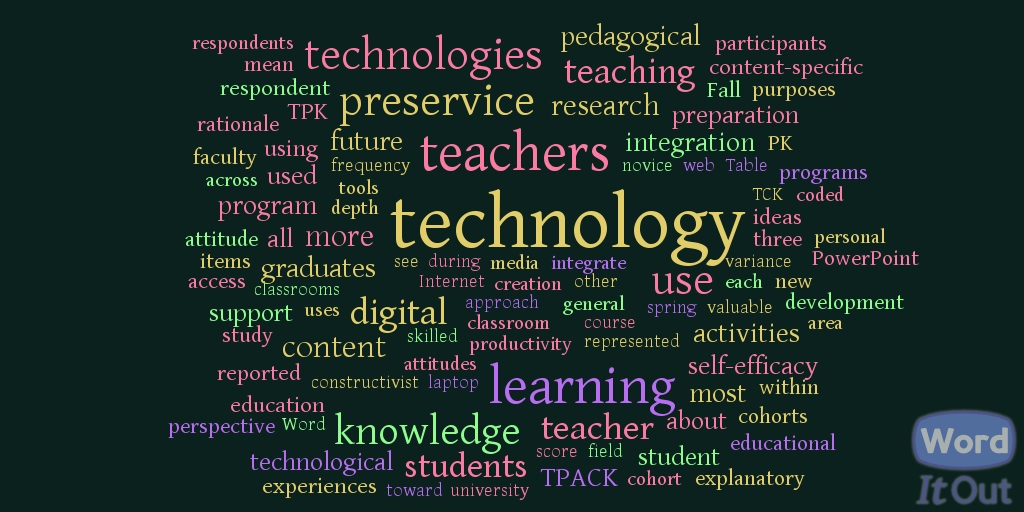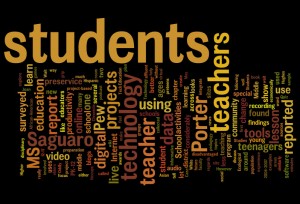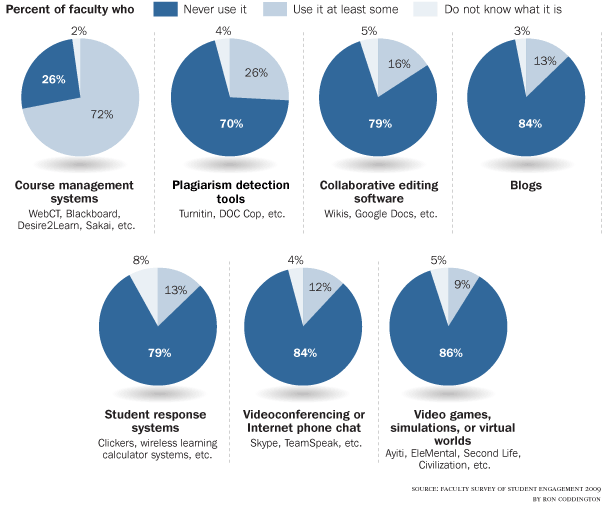WordCloud: Article on Preservice Teachers’ Technology Development in a Laptop Preparation Program
Here’s a WordCloud representation of a recent article we have written about preservice teachers and their use of technology in their program as well as how they are thinking in terms of their future use of technology as classroom teachers. In academia, there are stringent limits of “publishing” one’s work before release in a journal, and journals consider publication on the web as “already published.” In order to safeguard our ability to publish our work, but also share some of our work in a more timely fashion, we are doing so through the use of wordclouds. This cloud below represents what we wrote in the approximately 6,000 words, including our introduction, literature review, methods, results, and discussion.
if this inspires your interest, feel free to email Joan Hughes (joanh @ austin dot utexas dot edu) for more information or to discuss this in more detail.
TechEdges presents research at AERA 2011 in New Orleans, LA; April 8-9, 2011
My research group is presenting several research papers at the American Educational Research Association’s annual conference in New Orleans, LA. We will be posting our handouts and presentation materials here at this website following our presentations. We would be delighted to meet you. Here are our sessions:
Session 1:
“Degree of Digital Equity in Schools by Race and Socioeconomic Characteristics” by Gloria Gonzales Dholakia, Joan E. Hughes, and Michelle Fulks Read
Friday, April 8, 2011 from 12:00 PM to 1:30 PM
Location: Sheraton Grand Ballroom B
In Session “Issues Associated with Technology in Teaching and Learning”
Abstract: This research examines and compares digital equity at two different middle schools. Focus is placed upon minority student in- and out-of-school technology use to explore the relationship of school characteristics and digital equity. The first middle school is a minority-majority school, with 93% Hispanic and African-American students. The second middle school is a historically white majority school participating in a district student-transfer program with a 50% white and 50% Hispanic/African American population. Digital inequities based on school socio-economic status and ethnicity are presented. Without addressing these unequal opportunities to acquire 21st century skills, educational change cannot be achieved.
Session 2:
“Research Snapshots from 2002-2010 on Preparing Preservice Teachers to Integrate Technology Into Teaching Within a 1:1 Laptop Teacher Education Program” by Joan E. Hughes, Hyojin Yoon, Nikki Wen, and Minwook Ok
Friday, April 8, 2011 from 4:05 PM to 5:35 PM
Location: New Orleans Marriott / Mardi Gras Salon A
In Session: Laptops in Preservice Teacher Education
Abstract: This paper is a compilation of recent research that has been conducted to understand the development of preservice teachers that are enrolled in a technology-rich teacher education program. This program is described as technology-rich to reflect its commitment to a 1:1 laptop environment in which all certification students had their own laptop for their certification studies. This paper attempts support dissemination and scale-up by providing a case of one technology-rich program including its programmatic description and the research base generated from studies set within it. Further, we aim for this work to generate discussion and orientation for future inter-institutional research in technology-rich teacher education.
Session 3:
“An Ecological Case Study of Two Middle Schools’ Technology Integration” by Michelle Fulks Read, Sara Jolly Jones, Joan E. Hughes, and Gloria Gonzales Dholakia
Saturday, April 9, 2011 from 10:35 AM to 12:05 PM
Location: Astor Crowne Plaza / Toulouse A
In Session: Clearing Technology Integration Hurdles in K-12
Abstract: In this series of ethnographic case studies, we utilize mixed methods to examine technology integration at schools that represent differing demographics, geographical locations and technology infrastructure. The first data set, collected from Saguaro Middle School in spring 2009, is compared with data collected from Porter Middle School in spring 2010 in which students, teachers and technology leaders are questioned. Results show wide digital technology usage for web, productivity, communication and creation domains for students and teachers at both schools. However, a large gap exists in the amount of student usage in- and out-of schools. The size of this gap differs between schools. School and district technology leaders rank a variety of elements important to their school’s technology vision.
Happy New Year from TechEdges! Check out our Web Site as a Word Cloud
As of January 7, 2011, the word cloud below is a representation of all the content on our website. We love it!
Remember a word cloud uses color and font size to approximate patterns of word usage. Based on this word cloud, you can see that our relatively most used words are students, teachers, technology, teacher, Saguaro, and Porter. We think this makes a lot of sense as it represents our focal informants (with the exception of leaders) and mentions our first two case study school names.
Wait, wait don’t tell me… a live show from UT graduate students (example tech-supported lesson)
I’m sharing one of the lesson activities my students completed in my graduate course, “Teaching and Learning with the Internet” taught in Fall 2010 at The University of Texas at Austin.
The lesson is called Wait, wait, don’t tell me! The Oddly Informative Tech Quiz. No doubt this will sound familiar as it is built off of the popular NPR show of almost the same name.
I had several goals in mind for this lesson. I wanted students: (a) to realize the range of Internet-based news sources related to education, such as through websites, blogs, twitter feeds, communities, etc. (b) to begin following a few of these sources for at least a few weeks, (c) to engage with the information by participating in a live news quiz show, and (d) to practice podcast development.
The live show occurred on November 2 (election day). Students were responsible for recording the live show in order to then produce the podcast. They used various tools for recording, such as computers, Audacity, digital voice recorders, wireless and wired microphones, and even an iPhone (as a backup – which turned out to be needed!).
Please listen to the live show (34 minutes with 4 episodes – each are about 7 minutes each):
The lesson plan, instructions, and rubric I developed can be found below.
Faculty use of technology: general faculty (chronicle of educ stats) and in teacher education (our stats)
A report from The Chronicle of Higher Education on faculty’s use of technology yielded the following data:
Image Source: The Chronicle of Higher Education; http://chronicle.com/article/Professors-Use-of/123682; June 25, 2010.
Discussion around these data include questions of whether technology makes a better teacher. Certainly an excellent question! We do not believe that using technology will magically make a teacher a better teacher – in fact, at first, many teachers (and university faculty) may face some hiccups as they learn to teacher in a more student-centered way, as many of these technological tools are best used by students to learn. Faculty do not experience hiccups when they adopt technology in support of the usual, teacher-directed pedagogy that we know very well.
We (Joan Hughes with Gloria Gonzales Dholakia, Yu-Chi Wen, and Hyo-Jin Yoon) have a book chapter currently under review called “The iron grip of productivity software within teacher education.” In the chapter, we discuss the importance of faculty modeling of optimal technology use for preservice teachers, as they learn a lot about what they will do as future teachers from what they experience in their teacher preparation program. Yet, we also describe productivity software’s (tools like PowerPoint, word processing, and spreadsheet suites) enduring grip as the most used digital technologies among preservice teachers during teacher education.
The Chronicle’s data (above) reminds us of the data we have collected from preservice teachers. Clearly, there’s ample room to discuss why productivity is emphasized so much (been around a long time, has affordances across disciplinary areas). But we believe an overemphasis on productivity tools is not adequately preparing new teachers for the knowledge society in which we/they live, work, and educate.
We are not faulting teacher education or PK-12 schools or preservice teachers. But we recommend that this focus will not change without concerted change efforts in both teacher education and PK-12 institutions because change in one won’t really have a ripple effect without simultaneous and complementary change in the other.
A glimpse into our data … reveals the high-use digital technology tools by student teachers in 2004-2007 were: email, presentation, search engine, web browser, word processing, and digital movies (student teachers are required to do a lesson study involving video recording their teaching). Overall, data from our student teacher respondents in 2004-2007 and 2008-2009 reflect a low, but emergent use of minimal Web 2.0 tools such as blogs, podcasts, wiki, and social bookmarking. We feel this is a positive trend toward better preparation of teachers to integrate technology into their future PK-12 teaching, but we feel a necessity for more emphasis and progress.
Unsung Heroes Grant Program for Innovative Teachers ($2K – 25K awards!)
ING sponsors an Unsung Heroes, a grant program for K-12 educators “utilizing new teaching methods and techniques that improve learning.” Their 2011 program is accepting applications now. 100 educators will earn $2,000 towards their projects and a few special teachers may win much more. The deadline is April 30, 2011.
Their awards to teachers in 2010 involve examples of interdisciplinary projects (merging topics across disciplinary domains like literacy and math), hands-on / project-based pedagogy in which the students are getting their hands dirty with applying concepts, such as growing gardens, building robots, working with seniors or those younger to teach and learn, and a lot of service learning projects in which their outcomes has value for the community in which the students live.
I also looked across the 2010 winners for examples of uses of technology being incorporated into the projects. Teachers are using graphing calculators, emulator software, interactive boards, and digital projects to help students explore fundamental algebraic functions; using digital audio capture to create audio snapshots of storytelling to be later written into text-based stories (by 1st graders); use of virtual fields trips to broaden students’ conceptions of culture and tolerance; creating video public service announcements on healthy living topics; several projects involved robotics and machines; more use of video and audio to document history and legacy of one’s community with multimedia products published on a wiki.
A special congratulations to our Texan educators who won awards. All the projects involved technology in some way. Michelle Yates (Coder Elementary) in Forth Worth is instigating project-based learning through pre-created tubs that allow students to explore themes. “Students will integrate technology, story telling, visual presentations and communications skills in a non-competitive fashion in an effort to create a relevant project that can be integrated into their family and community.” Kellye Parker (San Antonio School for Inquiry & Creativity) has created a project that is really valuable as she teams her 8th grade students with elders in the community in which the students help the elders learn about texting, digital photography, video film, basic computer skills and user-friendly software. There’s a lot of room for growth in this area of partnership. Finally, Betty Johnson, Astra Zeno and Dr. Anil Kumar of Clifton Middle School (Houston) incorporate video documentaries into their students’ exploration of ecosystems with special emphasis on solar energy science.
Determining Teachers’ Digital Technology Self-Efficacy
My colleague, Dr. Jayson Richardson, at the University of Kentucky emailed me inquiring about how we measure digital technology self-efficacy which he saw on some of our slides in SlideShare.
I figured that others might also be interested. I created a PDF of our scale measure which is based off of an earlier measure created by Cassidy & Eachus (2002). We made changes to the language and to some items that we felt were not pertinent once we expanded the notion of “computer” to that of “digital technology.” You can see our measure below with the items. You can download this file on slideshare.
We must acknowledge the good work of Cassidy & Eachus.
Cassidy, S., & Eachus, P. (2002). Developing the Computer User Self-Efficacy (CUSE) Scale: Investigating the Relationship Between Computer Self-Efficacy, Gender, and Experience with Computers. Journal of Educational Computing Research, 26(2), 133-153. http://baywood.metapress.com/link.asp?id=jgjr0kvlhrf7gcnv


